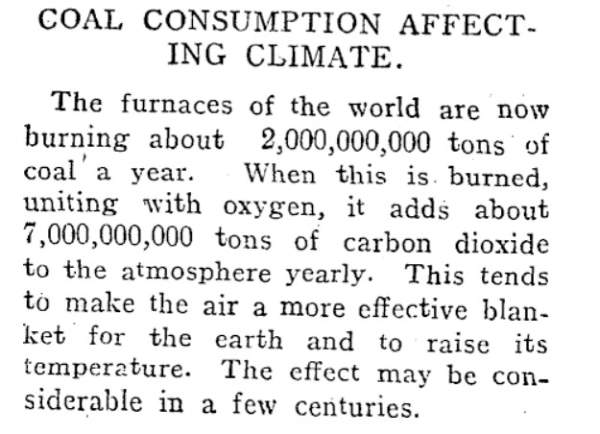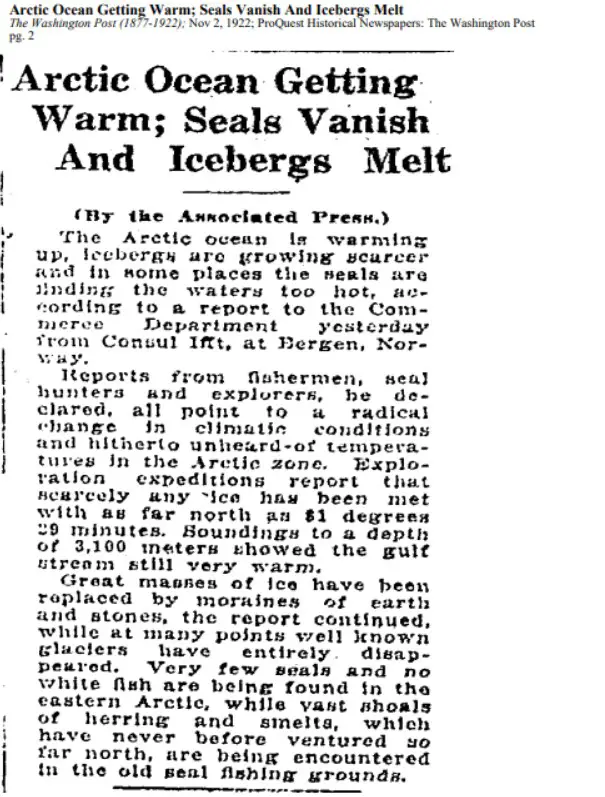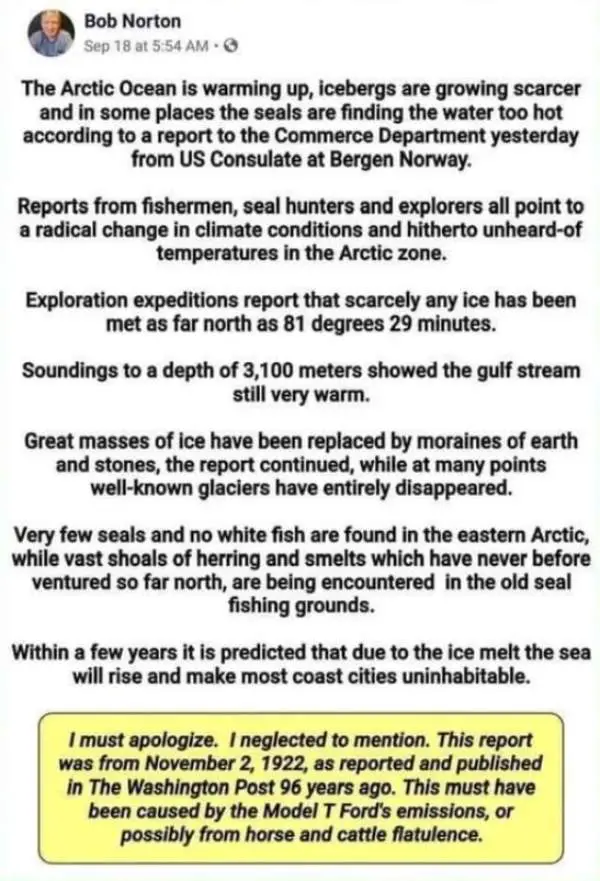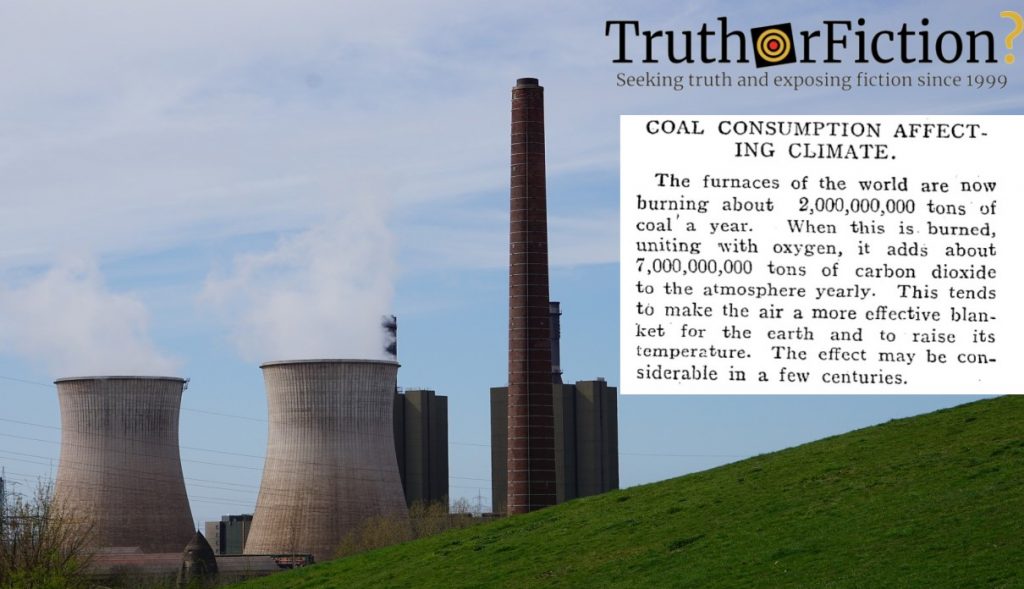Photographs of a 1912 newspaper article describing the effects of coal consumption on the atmosphere resurfaced online in August 2023, prompting a fresh round of attention on the earliest warnings of man-made climate change.
The article is legitimate, but its roots have been misidentified while being shared online at various points; it has been linked to the Rodney and Otatatea Times newspaper in New Zealand, but as more recent reports have noted, the story is taken from a piece that was originally published in the Braidwood Dispatch and Mining Journal in New South Wales in July 1912. It reads:
The furnaces of the world are now burning about 2,000,000,000 tons of coal a year. When this is burned, uniting with oxygen, it adds about 7,000,000,000 tons of carbon dioxide to the atmosphere yearly. This tends to make the air a more effective blanket for the earth and to raise its temperature. The effect may be considerable in a few centuries.

In 2016, a Facebook post by the Braidwood Museum spotlighting the article was shared thousands of times on the platform.
A similarly long-lived article, first published 10 years after the Mining Journal story, has been manipulated by social media users to go from a description of a local phenomenon to an attempt to dismiss climate change altogether.
The most widely-read version of this piece, bearing the headline “Arctic Ocean Getting Warm; Seals Vanish and Icebergs Melt,” was published in the Washington Post in November 1922. It reads in part:
The Arctic Ocean is warming up, icebergs are growing scarcer and in some places the seals are finding the water too hot, according to a report to the Commerce Department yesterday from Consul Ifft, at Bergen, Norway.
Reports from fishermen, seal hunters and explorers, he declared, all point to a radical change in climate conditions and hitherto unheard-of temperatures in the Arctic zone. Exploration expeditions report that scarcely any ice has been met with as far north as 81 degrees 29 minutes. Soundings to a depth of 3,100 meters showed the gulf stream still very warm.
Great masses of ice have been replaced by moraines of earth and stones, the report continued, while at many points well known glaciers have entirely disappeared. Very few seals and no white fish are found in the eastern Arctic, while vast shoals of herring and smelts, which have never before ventured so far north, are being encountered in the old seal fishing grounds.

The story, first published in the Monthly Weather Review, had previously been erroneously cited as a foreshadowing of modern climate change.
“Warm years in the past did happen — prior to the enormous effects of human-caused CO2 increase and warming,” Sridhar Anandakrishnan told Agence-France Presse in 2022. “They were part of the natural variability of the climate system that we are all familiar with.”
But as AFP also reported, a “copypasta” version of the story has also circulated with the addition of a section designed to mislead readers:
Within a few years it is predicted that due to the ice melt the sea will rise and make most coast cities uninhabitable.

This version also contains a postscript informing readers, “This must have been caused by the Model T. Ford’s emissions, or possibly from horse and cattle flatulence,” in order to mock actual concerns over a warming planet.
While the data used to compile the 1922 findings in Bergen are inapplicable to modern times, said University of Victoria professor Kate Moran, the world is presently in a climate emergency.
“The Arctic is warming faster and greater than almost any place on the planet,” said Moran, who leads the research group Ocean Networks Canada. “We have not seen this drastic of a change in perennial sea ice for over 15 million years.”
As CNN reported in June 2023, a study by researchers at Pohang University of Science and Technology in South Corea and published in the journal Nature Communications found that even if world governments drastically reduce emissions, the Arctic region could be devoid of sea ice in the summer as soon as the 2030s.
“We need to prepare ourselves for a world with warmer Arctic very soon,” said lead researcher Seung-Ki Min. “Since Arctic warming is suggested to bring weather extremes like heatwaves, wildfires, and floods on Northern mid- and high latitudes, the earlier onset of an ice-free Arctic also implies that we will be experiencing extreme events faster than predicted.”
Update 8/17/2023, 11:39 p.m.: This article has been revamped and updated. You can review the original here. — ag
- The New Zealand News Nugget Circling the Globe 110 Years After Publication
- Century-Old Arctic Rreport Altered to Discredit Global Warming
- The Arctic May Be Sea Ice-Free in Summer by the 2030s, New Study Warns
- Observationally-Constrained Projections of an Ice-Free Arctic Even Under a Low Emission Scenario

